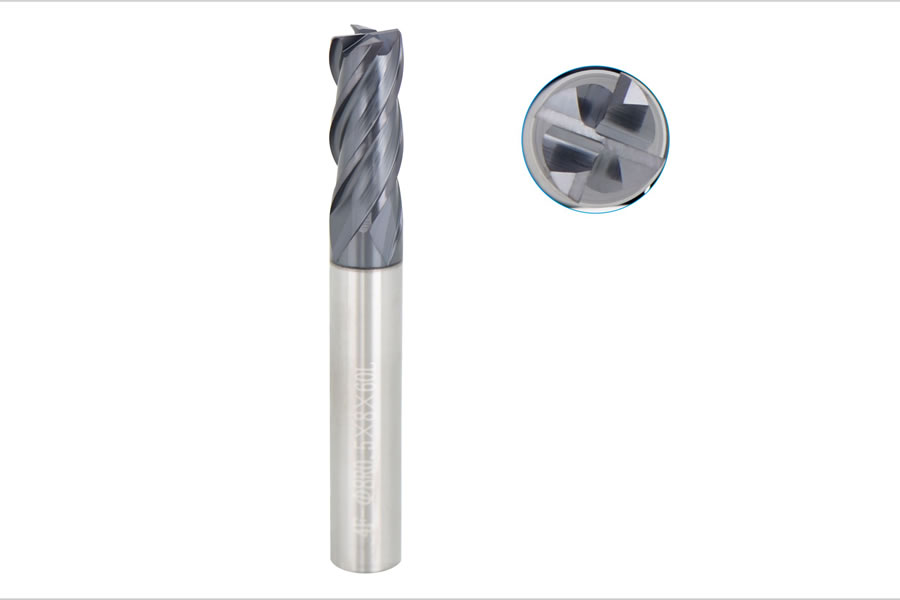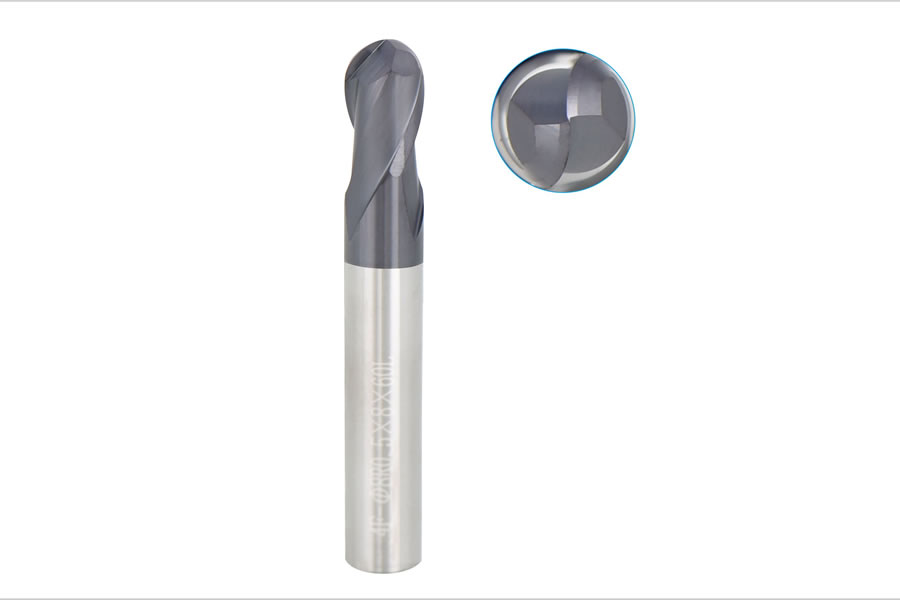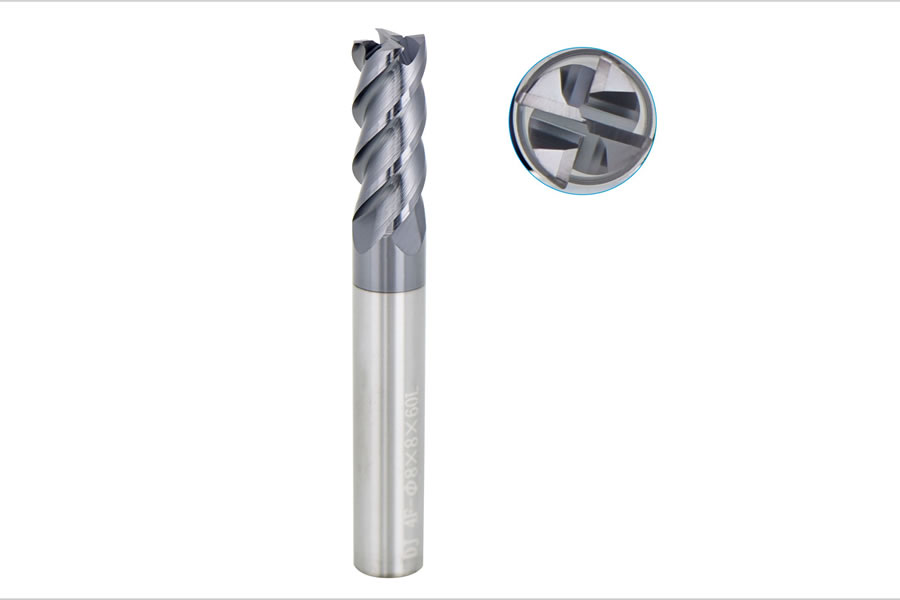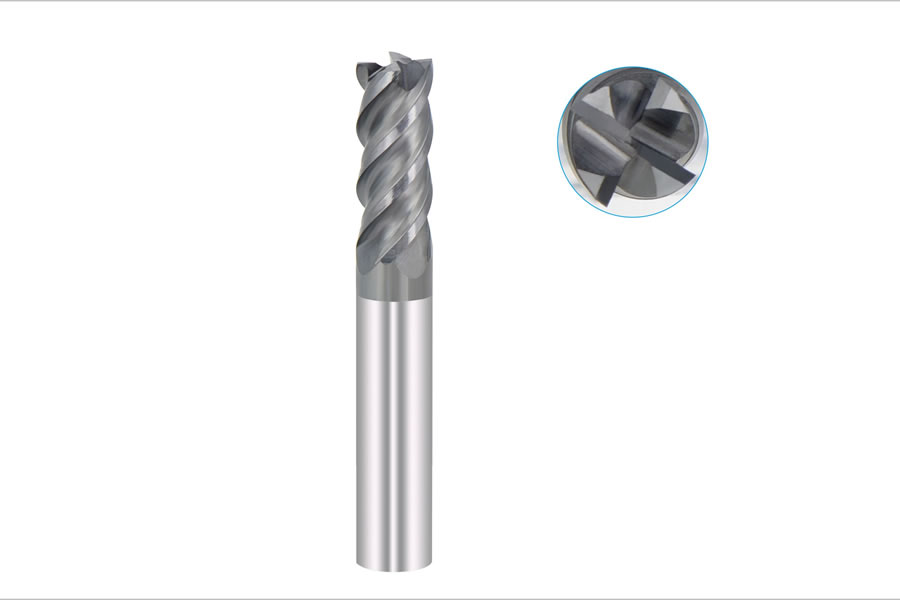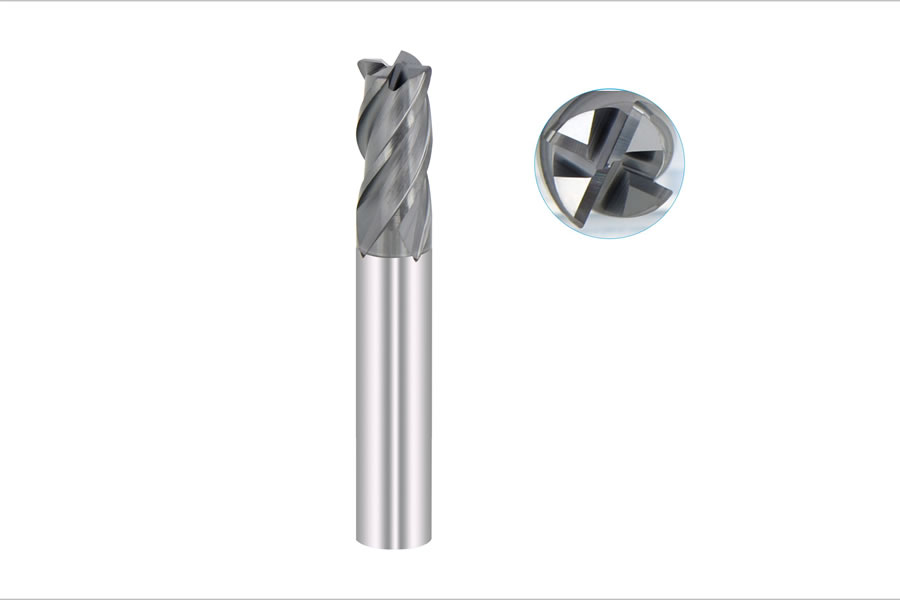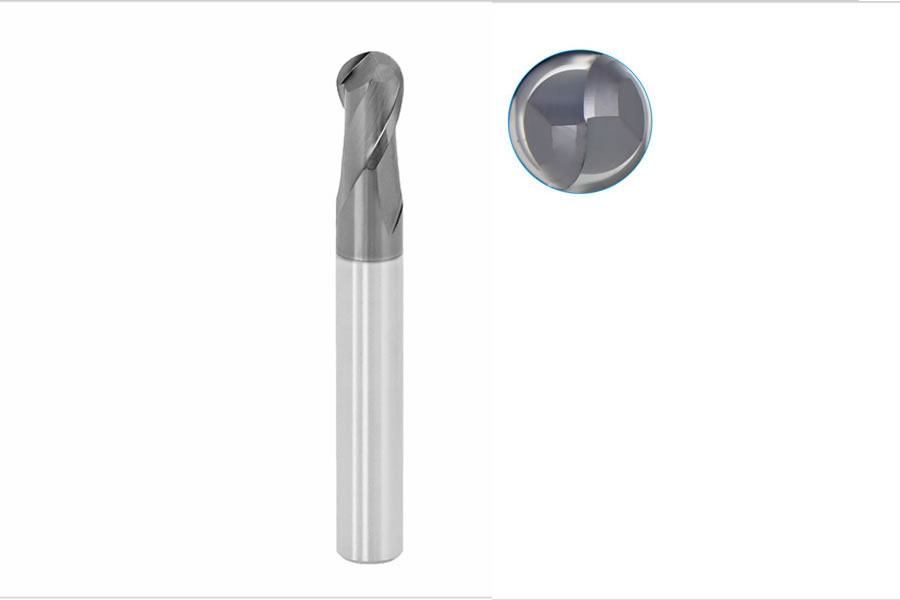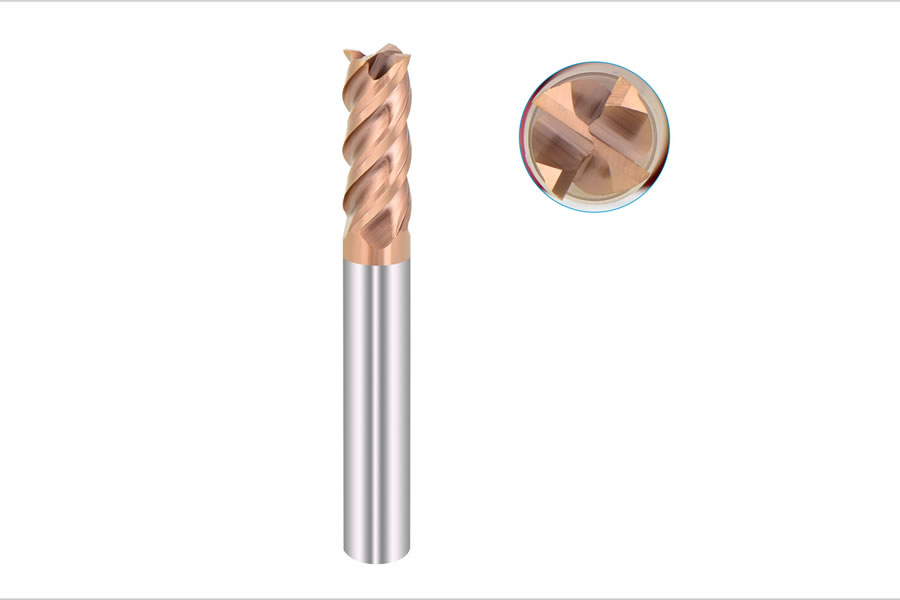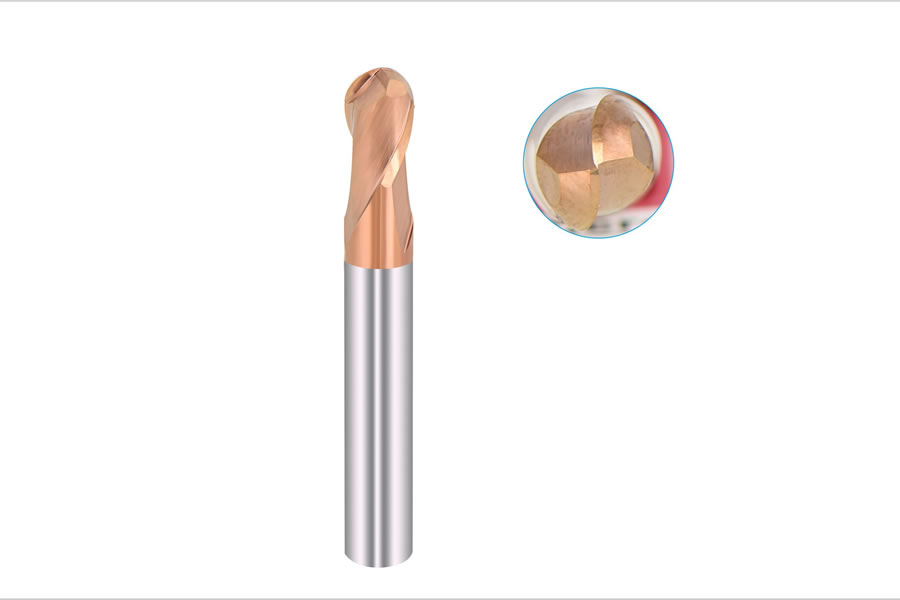
Basic knowledge of CNC tools
Update time:2020-05-25 22:02:57Click on the number of times:2247 numberFontSize:T|T
A good horse needs to be equipped with a good saddle and uses advanced CNC processing equipment. If the tool used is wrong, it is also worthless! Choosing the right tool material has a great impact on tool life, processing efficiency, processing quality a
A good horse needs to be equipped with a good saddle and uses advanced CNC processing equipment. If the tool used is wrong, it is also worthless! Choosing the right tool material has a great impact on tool life, processing efficiency, processing quality and processing cost. This article provides dry goods about tool knowledge, collect and forward, and learn together.
01
Tool materials should have basic properties
The choice of tool material has a great influence on tool life, processing efficiency, processing quality and processing cost. The tool must withstand high pressure, high temperature, friction, impact and vibration during cutting. Therefore, the tool material should have the following basic properties:
(1) Hardness and wear resistance. The hardness of the tool material must be higher than the hardness of the workpiece material, which is generally required to be above 60HRC. The higher the hardness of the tool material, the better the wear resistance.
(2) Strength and toughness. Tool materials should have high strength and toughness in order to withstand cutting forces, impacts and vibrations, to prevent tool brittle fracture and chipping.
(3) Heat resistance. The tool material has better heat resistance, can withstand high cutting temperatures, and has good oxidation resistance.
(4) Process performance and economy. Tool materials should have good forging performance, heat treatment performance, welding performance; grinding processing performance, etc., and should pursue a high performance-price ratio.
02
Type, performance, characteristics and application of tool materials
1. Diamond tool material
Diamond is an isomer of carbon. It is the hardest material that has been found in nature. Diamond tools have high hardness, high wear resistance and high thermal conductivity, and are widely used in the processing of non-ferrous and non-metallic materials. Especially in the high-speed cutting of aluminum and silicon aluminum alloys, diamond tools are the main cutting tool varieties that are difficult to replace. Diamond tools that can realize high-efficiency, high-stability and long-life machining are indispensable and important tools in modern CNC machining.
⑴ Types of diamond tools
① Natural diamond tool: Natural diamond has been used as a cutting tool for hundreds of years. The natural single crystal diamond tool has been finely ground, and the cutting edge can be extremely sharp. The cutting edge radius can reach 0.002μm, which can realize ultra-thin cutting. Machining extremely high workpiece precision and extremely low surface roughness is a recognized, ideal and irreplaceable ultra-precision machining tool.
② PCD diamond tools: natural diamond is expensive, and diamond is widely used in cutting or polycrystalline diamond (PCD). Since the early 1970s, polycrystalline diamond (Polycrystauine diamond, PCD blade for short) developed by high temperature and high pressure synthesis technology After success, natural diamond tools have been replaced by artificial polycrystalline diamond in many occasions. PCD raw materials are rich in source, and its price is only a few tenths to one tenth of natural diamonds. Want to learn UG programming can be in the group 565120797 can help you learn to improve. PCD tools can not grind extremely sharp edges, and the surface quality of the processed workpieces is not as good as natural diamond. Now the industry cannot easily manufacture PCD inserts with chip breakers. Therefore, PCD can only For precision cutting of non-ferrous metals and non-metals, it is difficult to achieve ultra-precision mirror cutting.
③ CVD diamond tools: From the late 1970s to the early 1980s, CVD diamond technology appeared in Japan. CVD diamond refers to the synthesis of diamond films on heterogeneous substrates (such as cemented carbide, ceramics, etc.) by chemical vapor deposition (CVD). CVD diamond has exactly the same structure and characteristics as natural diamond. The performance of CVD diamond is very close to that of natural diamond. It has the advantages of natural single crystal diamond and polycrystalline diamond (PCD), and overcomes their deficiencies to a certain extent.
⑵ Performance characteristics of diamond cutter
① Extremely high hardness and wear resistance: Natural diamond is the hardest substance found in nature. Diamond has extremely high wear resistance. When processing high hardness materials, the life of diamond tools is 10 to 100 times that of carbide tools, and even up to several hundred times.
② Has a very low friction coefficient: the friction coefficient between diamond and some non-ferrous metals is lower than other tools, the friction coefficient is low, the deformation during processing is small, and the cutting force can be reduced.
③ The cutting edge is very sharp: the cutting edge of the diamond tool can be sharply sharpened, and the natural single crystal diamond tool can be as high as 0.002 to 0.008 μm, which can perform ultra-thin cutting and ultra-precision machining.
④ High thermal conductivity: diamond has high thermal conductivity and thermal diffusivity, cutting heat is easily dissipated, and the temperature of the cutting part of the tool is low.
⑤ Has a low thermal expansion coefficient: The thermal expansion coefficient of diamond is several times smaller than that of cemented carbide, and the change in tool size caused by cutting heat is very small, which is particularly important for precision and ultra-precision machining that requires high dimensional accuracy.
⑶ Application of diamond cutter
Diamond tools are mostly used for fine cutting and boring non-ferrous and non-metallic materials at high speeds. Suitable for processing various wear-resistant non-metals, such as glass fiber reinforced plastic powder metallurgy blanks, ceramic materials, etc .; various wear-resistant non-ferrous metals, such as various silicon aluminum alloys; various non-ferrous metal finishing.
The disadvantage of diamond tools is poor thermal stability. When the cutting temperature exceeds 700 ℃ ~ 800 ℃, it will completely lose its hardness; in addition, it is not suitable for cutting ferrous metals, because diamond (carbon) is easy to contact iron at high temperatures The action of atoms converts carbon atoms into graphite structure, and the cutter is easily damaged.
2. Cubic boron nitride tool material
Cubic boron nitride (CBN), the second superhard material synthesized by a method similar to the diamond manufacturing method, is second only to diamond in terms of hardness and thermal conductivity. It has excellent thermal stability and is heated to 10000C in the atmosphere. No oxidation occurs. CBN has extremely stable chemical properties for ferrous metals and can be widely used in the processing of steel products.
⑴ Types of cubic boron nitride tools
Cubic boron nitride (CBN) is a substance that does not exist in nature, and is divided into single crystal and polycrystalline, namely CBN single crystal and polycrystalline cubic boron nitride (Polycrystalline cubic bornnitride, PCBN for short). CBN is one of the allotropes of boron nitride (BN), and its structure is similar to diamond.
PCBN (polycrystalline cubic boron nitride) is a polycrystalline material that sinters fine CBN materials through a combined phase (TiC, TiN, Al, Ti, etc.) under high temperature and high pressure. Diamond tool material, it and diamond are collectively called superhard tool material. PCBN is mainly used to make knives or other tools.
PCBN tools can be divided into integral PCBN blades and PCBN composite blades sintered with carbide.
PCBN composite blade is made by sintering a layer of O.5 ~ 1.0mm thick PCBN on a hard alloy with good strength and toughness. Its performance has good toughness and high hardness and wear resistance. It solves the problems of low bending strength and difficult welding of CBN blades.
⑵ The main performance and characteristics of cubic boron nitride
Although the hardness of cubic boron nitride is slightly inferior to diamond, it is far higher than other high hardness materials. The outstanding advantage of CBN is that its thermal stability is much higher than that of diamond, which can reach above 1200 ℃ (diamond is 700 ~ 800 ℃). reaction. The main performance characteristics of cubic boron nitride are as follows.
① High hardness and wear resistance: CBN crystal structure is similar to diamond, with hardness and strength similar to diamond. PCBN is particularly suitable for processing high-hardness materials that could only be ground before, and can obtain better workpiece surface quality.
② Has high thermal stability: CBN's heat resistance can reach 1400 ~ 1500 ℃, almost l times higher than the heat resistance of diamond (700 ~ 800 ℃) Want to learn UG programming can be in group 565120797 can help you learn to improve. PCBN tools can cut high-temperature alloys and hardened steels at high speeds 3 to 5 times higher than cemented carbide tools.
③ Excellent chemical stability: it does not play a chemical role with iron-based materials up to 1200-1300 ℃, and will not wear like diamonds. At this time, it can still maintain the hardness of cemented carbide; PCBN tools are suitable for cutting hardened steel Parts and chilled cast iron can be widely used for high-speed cutting of cast iron.
④ Has good thermal conductivity: Although the thermal conductivity of CBN can not catch up with diamond, PCBN is second only to diamond in thermal conductivity of various tool materials, which is much higher than that of high-speed steel and cemented carbide.
⑤ Has a low coefficient of friction: a low coefficient of friction can cause the cutting force to decrease during cutting, the cutting temperature to decrease, and the quality of the processed surface to improve.
⑶ cubic boron nitride tool application
Cubic boron nitride is suitable for finishing various hardened materials such as hardened steel, hard cast iron, high temperature alloy, cemented carbide, surface sprayed materials. The processing precision can reach IT5 (the hole is IT6), and the surface roughness value can be as small as Ra1.25 ~ 0.20μm.
The toughness and bending strength of cubic boron nitride tool materials are poor. Therefore, cubic boron nitride turning tools are not suitable for roughing at low speeds and large impact loads; at the same time, they are not suitable for cutting materials with high plasticity (such as aluminum alloys, copper alloys, nickel-based alloys, and steels with high plasticity) Metal will produce serious built-up edge, which will deteriorate the processed surface.
3. Ceramic tool material
Ceramic tools have the characteristics of high hardness, good wear resistance, excellent heat resistance and chemical stability, and are not easy to bond with metals. Ceramic tools occupy a very important position in CNC machining. Ceramic tools have become one of the main tools for high-speed cutting and machining of difficult-to-machine materials. Ceramic tools are widely used in high-speed cutting, dry cutting, hard cutting and cutting of difficult-to-machine materials. Ceramic tools can efficiently process high-hard materials that traditional tools can't process at all, achieving "turning instead of grinding"; the optimal cutting speed of ceramic tools can be 2 to 10 times higher than that of cemented carbide tools, thereby greatly improving the production efficiency of cutting processing ; Want to learn UG programming can be in group 565120797 can help you learn to improve. The main raw materials used in ceramic tool materials are the most abundant elements in the earth's crust. Therefore, the promotion and application of ceramic tools is very important for improving productivity, reducing processing costs, and saving strategic precious metals, and will also greatly promote the progress of cutting technology. .
⑴ Types of ceramic cutter materials
The types of ceramic cutter materials can be generally divided into three categories: alumina-based ceramics, silicon nitride-based ceramics, and composite silicon nitride-alumina-based ceramics. Among them, alumina-based and silicon nitride-based ceramic tool materials are the most widely used. The performance of silicon nitride-based ceramics is superior to alumina-based ceramics.
⑵ Performance and characteristics of ceramic cutter
① High hardness and good wear resistance: Although the hardness of ceramic tools is not as high as PCD and PCBN, it is much higher than that of carbide and high-speed steel tools, reaching 93-95HRA. Ceramic tools can process high-hard materials that traditional tools are difficult to process, and are suitable for high-speed cutting and hard cutting.
② High temperature resistance and good heat resistance: ceramic tools can still cut at high temperatures above 1200 ℃. Ceramic tools have good high-temperature mechanical properties, A12O3 ceramic tools have particularly good oxidation resistance, and the cutting edge can be used continuously even if it is in a red hot state. Therefore, ceramic cutting tools can achieve dry cutting, which can save cutting fluid.
③ Good chemical stability: ceramic tools are not easy to bond with metal, and corrosion resistance and chemical stability are good, which can reduce the bonding wear of the tool.
④ Low friction coefficient: The affinity of ceramic tools and metal is small, and the friction coefficient is low, which can reduce the cutting force and cutting temperature.
⑶ Ceramic knife has application
Ceramic is one of the cutting tool materials mainly used for high-speed finishing and semi-finishing. Ceramic cutters are suitable for cutting various cast irons (gray cast iron, ductile iron, malleable cast iron, chilled cast iron, high alloy wear-resistant cast iron) and steel materials (carbon structural steel, alloy structural steel, high strength steel, high manganese steel, quenched steel Etc.) can also be used to cut copper alloys, graphite, engineering plastics and composite materials.
The performance of ceramic tool materials has the problems of low bending strength and poor impact toughness, which is not suitable for cutting under low speed and impact load.
4. Coated tool material
Coating the tool is one of the important ways to improve the performance of the tool. The emergence of coated tools has made a major breakthrough in cutting performance. Coated tools are coated with one or more layers of refractory compounds with good wear resistance on the tool body with good toughness. It combines the tool base with a hard coating, thereby greatly improving the performance of the tool. Coated tools can improve processing efficiency, improve processing accuracy, extend tool life, and reduce processing costs.
About 80% of the cutting tools used in the new CNC machine tools use coated tools. Coated tools will be the most important tool varieties in the field of CNC machining in the future.
⑴ Types of coated tools
According to different coating methods, coated tools can be divided into chemical vapor deposition (CVD) coated tools and physical vapor deposition (PVD) coated tools. Coated cemented carbide tools generally use chemical vapor deposition method, the deposition temperature is about 1000 ℃. Coated high-speed steel tools generally use physical vapor deposition method, the deposition temperature is about 500 ℃;
According to the different base materials of coated cutters, coated cutters can be divided into cemented carbide coated cutters, high-speed steel coated cutters, and coated cutters on ceramic and superhard materials (diamond and cubic boron nitride).
According to the nature of the coating material, coated tools can be divided into two categories, namely "hard" coated tools and "soft" coated tools. The main goals pursued by "hard" coated tools are high hardness and wear resistance The main advantages are high hardness and good wear resistance, typically TiC and TiN coatings. The goal of "soft" coated tools is a low friction coefficient, also known as self-lubricating tools, which rubs against the workpiece material The coefficient is very low, only about 0.1, which can reduce bonding, reduce friction, and reduce cutting force and cutting temperature.
Recently developed a nano-coated (Nanoeoating) tool. This coating tool can use different combinations of multiple coating materials (such as metal / metal, metal / ceramic, ceramic / ceramic, etc.) to meet different functional and performance requirements. The well-designed nano coating can make the tool material have excellent anti-friction and anti-wear functions and self-lubricating properties, which is suitable for high-speed dry cutting.
⑵ Features of coated tools
① Good mechanical and cutting performance: the coated cutter combines the excellent performance of the base material and the coating material, which not only maintains the good toughness and high strength of the base, but also has the high hardness, high wear resistance and low Coefficient of friction. Therefore, the cutting speed of coated tools can be increased by more than 2 times than uncoated tools, and a higher feed rate is allowed. The life of coated tools has also been improved.
② Strong versatility: Coated tools have wide versatility, and the processing range is significantly expanded. A coated tool can replace several uncoated tools.
③ Coating thickness: As the coating thickness increases, the tool life will also increase, but when the coating thickness reaches saturation, the tool life will no longer increase significantly. When the coating is too thick, it is easy to cause peeling; when the coating is too thin, the wear resistance is poor.
④ Regrindability: Coated blades have poor regrindability, complex coating equipment, high process requirements and long coating time.
01
Tool materials should have basic properties
The choice of tool material has a great influence on tool life, processing efficiency, processing quality and processing cost. The tool must withstand high pressure, high temperature, friction, impact and vibration during cutting. Therefore, the tool material should have the following basic properties:
(1) Hardness and wear resistance. The hardness of the tool material must be higher than the hardness of the workpiece material, which is generally required to be above 60HRC. The higher the hardness of the tool material, the better the wear resistance.
(2) Strength and toughness. Tool materials should have high strength and toughness in order to withstand cutting forces, impacts and vibrations, to prevent tool brittle fracture and chipping.
(3) Heat resistance. The tool material has better heat resistance, can withstand high cutting temperatures, and has good oxidation resistance.
(4) Process performance and economy. Tool materials should have good forging performance, heat treatment performance, welding performance; grinding processing performance, etc., and should pursue a high performance-price ratio.
02
Type, performance, characteristics and application of tool materials
1. Diamond tool material
Diamond is an isomer of carbon. It is the hardest material that has been found in nature. Diamond tools have high hardness, high wear resistance and high thermal conductivity, and are widely used in the processing of non-ferrous and non-metallic materials. Especially in the high-speed cutting of aluminum and silicon aluminum alloys, diamond tools are the main cutting tool varieties that are difficult to replace. Diamond tools that can realize high-efficiency, high-stability and long-life machining are indispensable and important tools in modern CNC machining.
⑴ Types of diamond tools
① Natural diamond tool: Natural diamond has been used as a cutting tool for hundreds of years. The natural single crystal diamond tool has been finely ground, and the cutting edge can be extremely sharp. The cutting edge radius can reach 0.002μm, which can realize ultra-thin cutting. Machining extremely high workpiece precision and extremely low surface roughness is a recognized, ideal and irreplaceable ultra-precision machining tool.
② PCD diamond tools: natural diamond is expensive, and diamond is widely used in cutting or polycrystalline diamond (PCD). Since the early 1970s, polycrystalline diamond (Polycrystauine diamond, PCD blade for short) developed by high temperature and high pressure synthesis technology After success, natural diamond tools have been replaced by artificial polycrystalline diamond in many occasions. PCD raw materials are rich in source, and its price is only a few tenths to one tenth of natural diamonds. Want to learn UG programming can be in the group 565120797 can help you learn to improve. PCD tools can not grind extremely sharp edges, and the surface quality of the processed workpieces is not as good as natural diamond. Now the industry cannot easily manufacture PCD inserts with chip breakers. Therefore, PCD can only For precision cutting of non-ferrous metals and non-metals, it is difficult to achieve ultra-precision mirror cutting.
③ CVD diamond tools: From the late 1970s to the early 1980s, CVD diamond technology appeared in Japan. CVD diamond refers to the synthesis of diamond films on heterogeneous substrates (such as cemented carbide, ceramics, etc.) by chemical vapor deposition (CVD). CVD diamond has exactly the same structure and characteristics as natural diamond. The performance of CVD diamond is very close to that of natural diamond. It has the advantages of natural single crystal diamond and polycrystalline diamond (PCD), and overcomes their deficiencies to a certain extent.
⑵ Performance characteristics of diamond cutter
① Extremely high hardness and wear resistance: Natural diamond is the hardest substance found in nature. Diamond has extremely high wear resistance. When processing high hardness materials, the life of diamond tools is 10 to 100 times that of carbide tools, and even up to several hundred times.
② Has a very low friction coefficient: the friction coefficient between diamond and some non-ferrous metals is lower than other tools, the friction coefficient is low, the deformation during processing is small, and the cutting force can be reduced.
③ The cutting edge is very sharp: the cutting edge of the diamond tool can be sharply sharpened, and the natural single crystal diamond tool can be as high as 0.002 to 0.008 μm, which can perform ultra-thin cutting and ultra-precision machining.
④ High thermal conductivity: diamond has high thermal conductivity and thermal diffusivity, cutting heat is easily dissipated, and the temperature of the cutting part of the tool is low.
⑤ Has a low thermal expansion coefficient: The thermal expansion coefficient of diamond is several times smaller than that of cemented carbide, and the change in tool size caused by cutting heat is very small, which is particularly important for precision and ultra-precision machining that requires high dimensional accuracy.
⑶ Application of diamond cutter
Diamond tools are mostly used for fine cutting and boring non-ferrous and non-metallic materials at high speeds. Suitable for processing various wear-resistant non-metals, such as glass fiber reinforced plastic powder metallurgy blanks, ceramic materials, etc .; various wear-resistant non-ferrous metals, such as various silicon aluminum alloys; various non-ferrous metal finishing.
The disadvantage of diamond tools is poor thermal stability. When the cutting temperature exceeds 700 ℃ ~ 800 ℃, it will completely lose its hardness; in addition, it is not suitable for cutting ferrous metals, because diamond (carbon) is easy to contact iron at high temperatures The action of atoms converts carbon atoms into graphite structure, and the cutter is easily damaged.
2. Cubic boron nitride tool material
Cubic boron nitride (CBN), the second superhard material synthesized by a method similar to the diamond manufacturing method, is second only to diamond in terms of hardness and thermal conductivity. It has excellent thermal stability and is heated to 10000C in the atmosphere. No oxidation occurs. CBN has extremely stable chemical properties for ferrous metals and can be widely used in the processing of steel products.
⑴ Types of cubic boron nitride tools
Cubic boron nitride (CBN) is a substance that does not exist in nature, and is divided into single crystal and polycrystalline, namely CBN single crystal and polycrystalline cubic boron nitride (Polycrystalline cubic bornnitride, PCBN for short). CBN is one of the allotropes of boron nitride (BN), and its structure is similar to diamond.
PCBN (polycrystalline cubic boron nitride) is a polycrystalline material that sinters fine CBN materials through a combined phase (TiC, TiN, Al, Ti, etc.) under high temperature and high pressure. Diamond tool material, it and diamond are collectively called superhard tool material. PCBN is mainly used to make knives or other tools.
PCBN tools can be divided into integral PCBN blades and PCBN composite blades sintered with carbide.
PCBN composite blade is made by sintering a layer of O.5 ~ 1.0mm thick PCBN on a hard alloy with good strength and toughness. Its performance has good toughness and high hardness and wear resistance. It solves the problems of low bending strength and difficult welding of CBN blades.
⑵ The main performance and characteristics of cubic boron nitride
Although the hardness of cubic boron nitride is slightly inferior to diamond, it is far higher than other high hardness materials. The outstanding advantage of CBN is that its thermal stability is much higher than that of diamond, which can reach above 1200 ℃ (diamond is 700 ~ 800 ℃). reaction. The main performance characteristics of cubic boron nitride are as follows.
① High hardness and wear resistance: CBN crystal structure is similar to diamond, with hardness and strength similar to diamond. PCBN is particularly suitable for processing high-hardness materials that could only be ground before, and can obtain better workpiece surface quality.
② Has high thermal stability: CBN's heat resistance can reach 1400 ~ 1500 ℃, almost l times higher than the heat resistance of diamond (700 ~ 800 ℃) Want to learn UG programming can be in group 565120797 can help you learn to improve. PCBN tools can cut high-temperature alloys and hardened steels at high speeds 3 to 5 times higher than cemented carbide tools.
③ Excellent chemical stability: it does not play a chemical role with iron-based materials up to 1200-1300 ℃, and will not wear like diamonds. At this time, it can still maintain the hardness of cemented carbide; PCBN tools are suitable for cutting hardened steel Parts and chilled cast iron can be widely used for high-speed cutting of cast iron.
④ Has good thermal conductivity: Although the thermal conductivity of CBN can not catch up with diamond, PCBN is second only to diamond in thermal conductivity of various tool materials, which is much higher than that of high-speed steel and cemented carbide.
⑤ Has a low coefficient of friction: a low coefficient of friction can cause the cutting force to decrease during cutting, the cutting temperature to decrease, and the quality of the processed surface to improve.
⑶ cubic boron nitride tool application
Cubic boron nitride is suitable for finishing various hardened materials such as hardened steel, hard cast iron, high temperature alloy, cemented carbide, surface sprayed materials. The processing precision can reach IT5 (the hole is IT6), and the surface roughness value can be as small as Ra1.25 ~ 0.20μm.
The toughness and bending strength of cubic boron nitride tool materials are poor. Therefore, cubic boron nitride turning tools are not suitable for roughing at low speeds and large impact loads; at the same time, they are not suitable for cutting materials with high plasticity (such as aluminum alloys, copper alloys, nickel-based alloys, and steels with high plasticity) Metal will produce serious built-up edge, which will deteriorate the processed surface.
3. Ceramic tool material
Ceramic tools have the characteristics of high hardness, good wear resistance, excellent heat resistance and chemical stability, and are not easy to bond with metals. Ceramic tools occupy a very important position in CNC machining. Ceramic tools have become one of the main tools for high-speed cutting and machining of difficult-to-machine materials. Ceramic tools are widely used in high-speed cutting, dry cutting, hard cutting and cutting of difficult-to-machine materials. Ceramic tools can efficiently process high-hard materials that traditional tools can't process at all, achieving "turning instead of grinding"; the optimal cutting speed of ceramic tools can be 2 to 10 times higher than that of cemented carbide tools, thereby greatly improving the production efficiency of cutting processing ; Want to learn UG programming can be in group 565120797 can help you learn to improve. The main raw materials used in ceramic tool materials are the most abundant elements in the earth's crust. Therefore, the promotion and application of ceramic tools is very important for improving productivity, reducing processing costs, and saving strategic precious metals, and will also greatly promote the progress of cutting technology. .
⑴ Types of ceramic cutter materials
The types of ceramic cutter materials can be generally divided into three categories: alumina-based ceramics, silicon nitride-based ceramics, and composite silicon nitride-alumina-based ceramics. Among them, alumina-based and silicon nitride-based ceramic tool materials are the most widely used. The performance of silicon nitride-based ceramics is superior to alumina-based ceramics.
⑵ Performance and characteristics of ceramic cutter
① High hardness and good wear resistance: Although the hardness of ceramic tools is not as high as PCD and PCBN, it is much higher than that of carbide and high-speed steel tools, reaching 93-95HRA. Ceramic tools can process high-hard materials that traditional tools are difficult to process, and are suitable for high-speed cutting and hard cutting.
② High temperature resistance and good heat resistance: ceramic tools can still cut at high temperatures above 1200 ℃. Ceramic tools have good high-temperature mechanical properties, A12O3 ceramic tools have particularly good oxidation resistance, and the cutting edge can be used continuously even if it is in a red hot state. Therefore, ceramic cutting tools can achieve dry cutting, which can save cutting fluid.
③ Good chemical stability: ceramic tools are not easy to bond with metal, and corrosion resistance and chemical stability are good, which can reduce the bonding wear of the tool.
④ Low friction coefficient: The affinity of ceramic tools and metal is small, and the friction coefficient is low, which can reduce the cutting force and cutting temperature.
⑶ Ceramic knife has application
Ceramic is one of the cutting tool materials mainly used for high-speed finishing and semi-finishing. Ceramic cutters are suitable for cutting various cast irons (gray cast iron, ductile iron, malleable cast iron, chilled cast iron, high alloy wear-resistant cast iron) and steel materials (carbon structural steel, alloy structural steel, high strength steel, high manganese steel, quenched steel Etc.) can also be used to cut copper alloys, graphite, engineering plastics and composite materials.
The performance of ceramic tool materials has the problems of low bending strength and poor impact toughness, which is not suitable for cutting under low speed and impact load.
4. Coated tool material
Coating the tool is one of the important ways to improve the performance of the tool. The emergence of coated tools has made a major breakthrough in cutting performance. Coated tools are coated with one or more layers of refractory compounds with good wear resistance on the tool body with good toughness. It combines the tool base with a hard coating, thereby greatly improving the performance of the tool. Coated tools can improve processing efficiency, improve processing accuracy, extend tool life, and reduce processing costs.
About 80% of the cutting tools used in the new CNC machine tools use coated tools. Coated tools will be the most important tool varieties in the field of CNC machining in the future.
⑴ Types of coated tools
According to different coating methods, coated tools can be divided into chemical vapor deposition (CVD) coated tools and physical vapor deposition (PVD) coated tools. Coated cemented carbide tools generally use chemical vapor deposition method, the deposition temperature is about 1000 ℃. Coated high-speed steel tools generally use physical vapor deposition method, the deposition temperature is about 500 ℃;
According to the different base materials of coated cutters, coated cutters can be divided into cemented carbide coated cutters, high-speed steel coated cutters, and coated cutters on ceramic and superhard materials (diamond and cubic boron nitride).
According to the nature of the coating material, coated tools can be divided into two categories, namely "hard" coated tools and "soft" coated tools. The main goals pursued by "hard" coated tools are high hardness and wear resistance The main advantages are high hardness and good wear resistance, typically TiC and TiN coatings. The goal of "soft" coated tools is a low friction coefficient, also known as self-lubricating tools, which rubs against the workpiece material The coefficient is very low, only about 0.1, which can reduce bonding, reduce friction, and reduce cutting force and cutting temperature.
Recently developed a nano-coated (Nanoeoating) tool. This coating tool can use different combinations of multiple coating materials (such as metal / metal, metal / ceramic, ceramic / ceramic, etc.) to meet different functional and performance requirements. The well-designed nano coating can make the tool material have excellent anti-friction and anti-wear functions and self-lubricating properties, which is suitable for high-speed dry cutting.
⑵ Features of coated tools
① Good mechanical and cutting performance: the coated cutter combines the excellent performance of the base material and the coating material, which not only maintains the good toughness and high strength of the base, but also has the high hardness, high wear resistance and low Coefficient of friction. Therefore, the cutting speed of coated tools can be increased by more than 2 times than uncoated tools, and a higher feed rate is allowed. The life of coated tools has also been improved.
② Strong versatility: Coated tools have wide versatility, and the processing range is significantly expanded. A coated tool can replace several uncoated tools.
③ Coating thickness: As the coating thickness increases, the tool life will also increase, but when the coating thickness reaches saturation, the tool life will no longer increase significantly. When the coating is too thick, it is easy to cause peeling; when the coating is too thin, the wear resistance is poor.
④ Regrindability: Coated blades have poor regrindability, complex coating equipment, high process requirements and long coating time.
Sohu.com (editor:www.dongjiesharp.com)
- Last one:Zhongyuan Petroleum Company developed a new type of nano diamond drill bit
- Next:no more
New Product Recommendation
